


 |
November 30, 2008: Barcelona (Day 3) |
 |
November 28, 2008: Barcelona (Day 1) |
 |
Return to the Europe/Cruise Trip Index |
A Rainy Morning Walk Near Plaza Catalunya
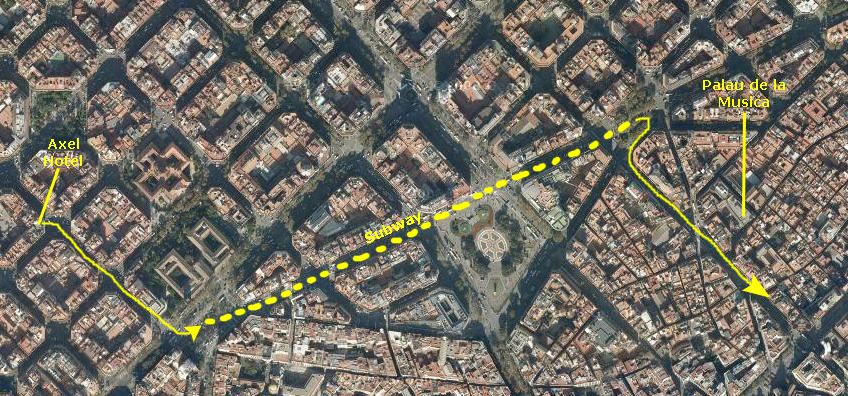 |
While we could have walked, since the day was so harsh, and since we needed subway passes for the weekend anyway, we decided to buy the passes and begin using them. We walked down to the University subway station and take the subway one stop beyond Placa Catalunya- the Urquinaona stop. When we got up from the subway, we began walking southeast along Via Laietana. This street took us to the corner at Carrer de Sant Pere Mes Alt, which is where we turned to walk over to the Palau.
When we arrived there, we found that the earliest tour that we could buy tickets for was 3PM, so we did that and then decided to do the Picasso Museum first.
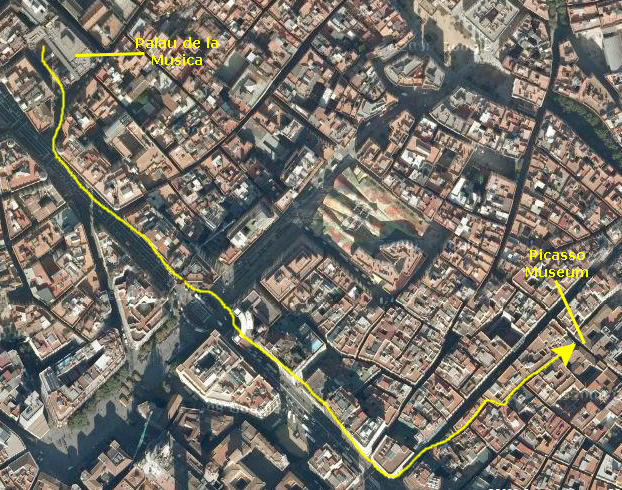 |
As we were walking down Via Laietana, we took some additional pictures, and you can look at them if you will click on the thumbnail images below:

A Tour of the Picasso Museum
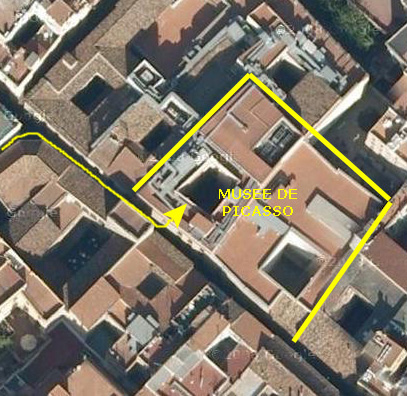 |

Walking from Museu Picasso to the Palau
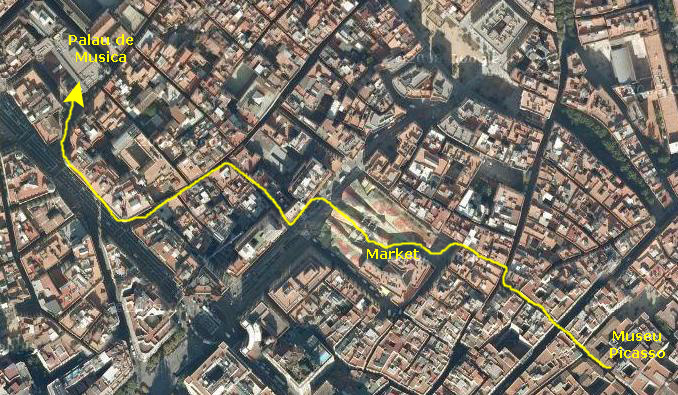 |
Then we crossed the street and headed down a small side passage, again working our way towards where we thought the Palau was. At one point, we came out into an open area adjacent to another market, much like the one we had walked through yesterday. I guess now that these markets are fairly common throughout downtown Barcelona; perhaps not as ubiquitous as American grocery stores, but enough in number that residents need not go a long ways to grocery shop.
One of the differences between this apparently newer and more expansive market and yesterday's was that this market had rather more areas where people could actually come to eat. Below are three thumbnail images for the photographs that we took in this market; click on them to view the full-size pictures:
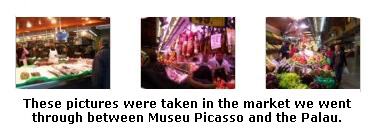
|
|
From this market, you can follow our route back to the Palau de Musica. Along the way we took some other pictures of interest, and you can look at them by clicking on the thumbnail images below:
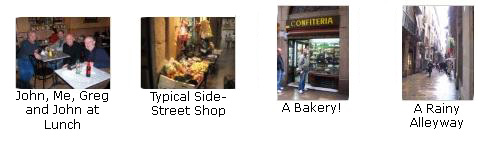
Perhaps the movie I took as we walked through the narrow streets, will give you a better idea of what the neighborhoods of downtown Barcelona are like.
|
|
A Tour of the Palau de la Musica
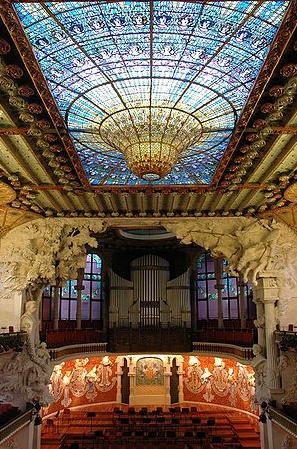 |
The design of the Palau is typical of Catalan modernism; rich decoration emphasizes floral and other organic motifs. But it must also be said that the design of the Palau is eminently rational. It pays strict attention to function and makes full use of the most up-to-date materials and technologies available at the beginning of the 20th century (e.g., steel framing). The wealthy citizens of Barcelona asked its architect for building materials and techniques that symbolized the Catalan national character. In response, he commissioned and gave great creative freedom to a variety of local artisans and craftsmen to produce the fabulous ornamentation, sculpture, and decorative structural elements for which the Palau is famous.
The rich decoration of the façade of the Palau, which incorporates elements from many sources, including traditional Spanish and Arabic architecture, is successfully married with the building's structure. The exposed red brick and iron, the mosaics, the stained glass, and the glazed tiles were chosen and situated to give a feeling of openness and transparency. Two colonnades enjoy a commanding position on the second-level balcony of the main façade. Each column is covered uniquely with multicolored glazed tile pieces in mostly floral designs and is capped with a candelabrum that at night blazes with light. Above the columns are large busts of Giovanni Pierluigi da Palestrina, Johann Sebastian Bach, and Ludwig van Beethoven on the main façade and Richard Wagner on the side. The top of the main façade is graced by a large allegoric mosaic by Lluís Bru that represents the members of the Orfeó Català, but it is impossible to see it clearly from the narrow street below.
The concert hall of the Palau, which seats about 2,200 people, is the only auditorium in Europe that is illuminated during daylight hours entirely by natural light. The walls on two sides consist primarily of stained-glass panes set in magnificent arches, and overhead is an enormous skylight of stained glass designed by Antoni Rigalt whose centerpiece is an inverted dome in shades of gold surrounded by blue that suggests the sun and the sky.
The architectural decoration in the concert hall is a masterpiece of creativity and imagination, yet everything has been carefully considered for its utility in the presentation of music- with the dominant theme being choral music, as befits an auditorium commissioned by a choral society. The remodeling and extension work on the Palau performed between 1982 and 1989 can only be called exemplary. It not only restored parts of the building to their original state but also expanded it and improved it technically so that it has many additional possible uses. From 2006 to 2008 some further restoration has been carried out: the lantern on the top of the tower on the corner of the building has been reinstalled, as well as some ornamental features of the facade. On one side of the structure, a glass curtain wall has been installed to protect the side facade and also to improve the lighting inside the auditorium.
(The inside pictures of the Palau were taken from Wikipedia; photography was not permitted on the tour we took of the inside of the concert hall.) We did take some other pictures outside the Palau, and if you would like to see these pictures, click on the thumbnail images below:

Fred and I Take an Afternoon Walk
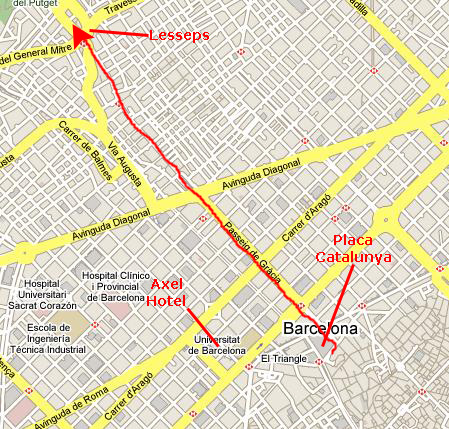 |
We didn't know much about the city, but we were already on what seemed to be a broad, main avenue- the Passeig de Gracia- and we decided just to walk north along that avenue towards the hills to see what we could see. As we walked along through the late afternoon shoppers and sightseers, we just marveled at the many beautiful buildings that we passed. On one corner along the Passeig de Gracia, for example, we found a beautiful apartment building whose ornamentation, it seemed to me, would have qualified it to be some national treasure anyplace in the United States.
We passed two buildings by Gaudi. One was an apartment building facing de Gracia, and there are some pictures of it below. The other was the famous Casa Mila la Padrera, the wildly fanciful apartment building that is one of his best-known creations. As we passed by it, Fred captured some of the Casa Mila la Padrera (which turned out not to be ornamental at all, but oddly functional). We did not know it at the time, but this building would be one of the stops we would make tomorrow. Just up the street from La Padrera was an interesting store- the Imaginarium- which we thought was a store for educational toys and games for kids.
We continued walking, and eventually got high up the Passeig de Gracia where the broad avenue ended and a more narrow street began. Here, the walking got even more interesting as we were in a more thoroughly residential area, with only small shops catering to the residents. We continued walking towards the mountains (generally north), passing many buildings that displayed wonderful architectural styles and embellishments. As we continued to walk up the hills, the light began to fade, and when we got to the Lessups subway stop, we decided that this would be a good place to end our walk. We were in a large intersection that was being rebuilt, and we were right in front of the Lsglesia Par Roquial Verge de Gracia St. Josep. We spent some time here taking pictures and enjoying the late afternoon before we got down into the subway again and headed back to the Axel. Other than the pictures referred to in this narrative, we took a good many excellent ones on our walk. If you want to see some of these pictures, click on the thumbnail images below:
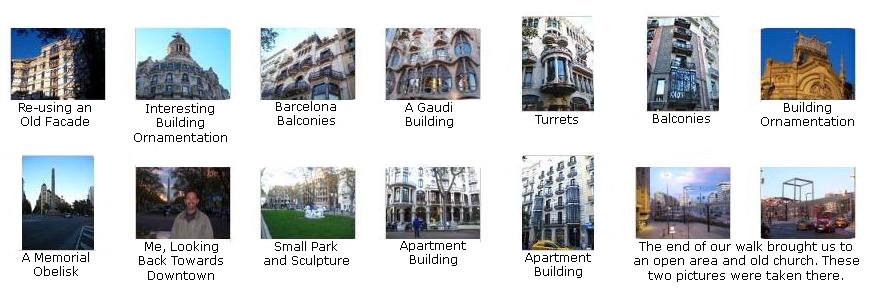
I Take an Evening Excursion
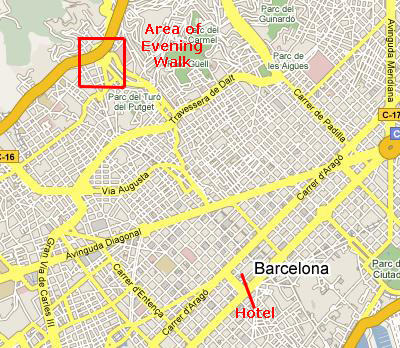 |
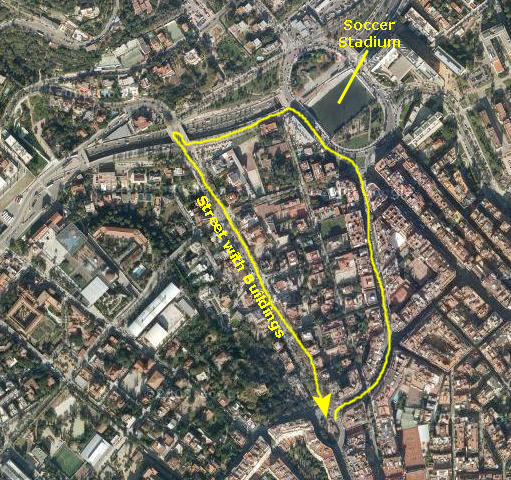 |
I started off by heading a bit northeast along a winding city street, past apartment buildings and little shops and stores. then I came out beside a large soccer stadium where there was an evening game going on. I walked a bit further north and found myself alongside an expressway. I walked along it for a block and then out onto one of the bridges across it. (Here, I made a movie that you can watch below.) From this vantage point, I could see that there was a large church, all lit up, way up the hillside, and, apparently, some sort of park. It was too dark to investigate, though.
Then I walked back down a main street that was lined with all sorts of beautifully decorated houses, but they were mostly nice offices, institutes or restaurants. You can see more of these buildings in the picture section below. Finally, I was back at the train station, and I just retraced my path back to the Axel Hotel, reaching the hotel just in time to rejoin our group and go out to dinner.
I have put some thumbnail images below for some of the pictures I took on this evening excursion, and you can click on those images to view the pictures:

|
|
You canuse the links below to go to another photo album page.
 |
November 30, 2008: Barcelona (Day 3) |
 |
November 28, 2008: Barcelona (Day 1) |
 |
Return to the Europe/Cruise Trip Index |